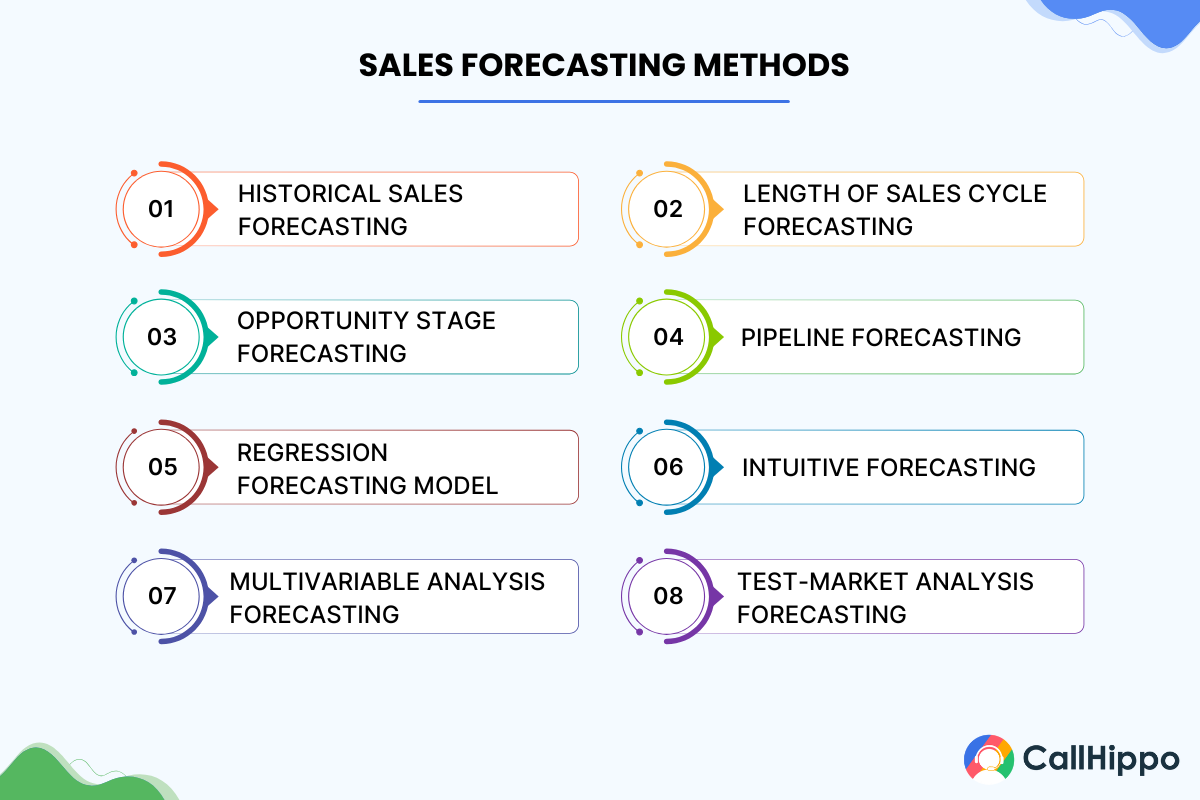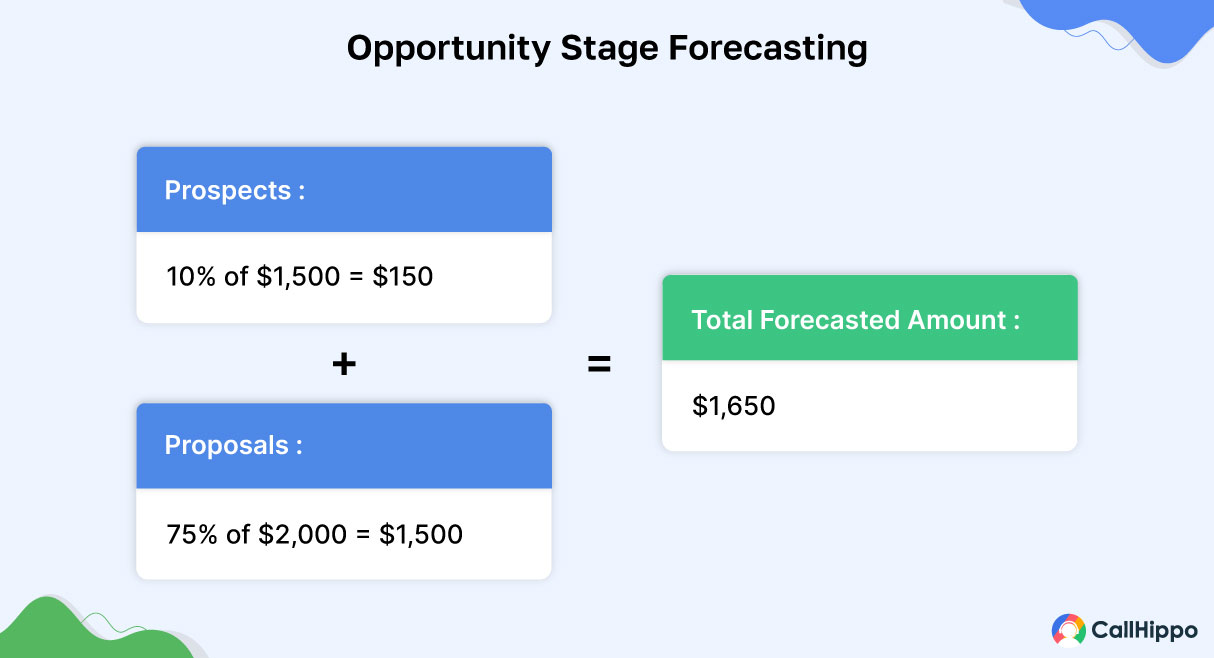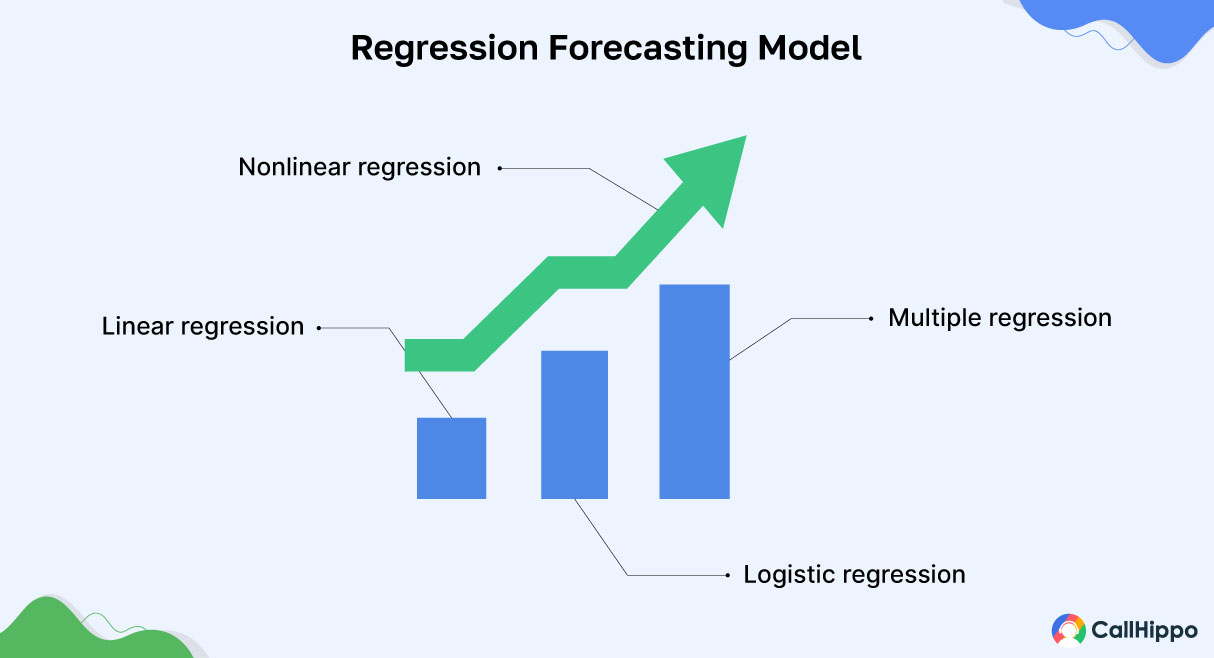Sales forecasting helps businesses estimate future sales, align marketing efforts, and make informed decisions. According to a study by Salesforce, companies with accurate sales forecasts are 10% more likely to grow revenue year-over-year. Whether you’re a small startup or a large enterprise, choosing the right sales forecasting methods can significantly improve your planning and performance.
Top 8 Sales Forecasting Methods in 10 seconds !
Sales forecasting is the process of predicting future sales over a specific time frame using historical data, current pipeline insights, and market trends. It enables businesses to plan strategically, set goals, manage resources, and reduce risks by estimating upcoming revenue.
Top 8 Sales Forecasting Methods :
- Historical Sales Forecasting: Uses past sales data to predict future performance, ideal for businesses with stable trends and repeat customers.
- Length of Sales Cycle Forecasting: Estimates revenue based on the average time it takes to close deals, helping to forecast sales timing more accurately.
- Opportunity Stage Forecasting: Assigns probabilities to deals at different pipeline stages to forecast revenue based on deal progression.
- Pipeline Forecasting: Evaluates all current deals considering their value, stage, and past close rates to provide a real-time, overall revenue estimate.
- Regression Forecasting Model: Uses statistical models to predict sales by analysing relationships between sales and various influencing factors like marketing spend or seasonality.
- Intuitive Forecasting: Relies on sales reps' or managers’ gut feelings and experience to estimate future sales, often used when data is scarce.
- Multivariable Analysis Forecasting: Combines multiple data points like deal stage, rep performance, and market conditions using algorithms for a more accurate forecast.
- Test-Market Analysis Forecasting: Tests a product in a small market and uses the results to project broader sales outcomes before a full-scale launch.
What is Sales Forecasting?
Sales forecasting is the process of estimating future sales over a specific period using historical data, market trends, and other critical business insights. It involves analysing past performance, evaluating current pipeline health, and considering external factors to predict upcoming revenue. Businesses use various sales forecasting techniques to gain clarity on what lies ahead, enabling better decision-making, resource allocation, and goal setting.
Start with simple methods like historical or opportunity stage forecasting to build a strong foundation, especially if your data is limited. As your business scales, combine multiple forecasting techniques—like regression or multivariable analysis—for deeper, more accurate revenue insights.
Why is Sales Forecasting Important?
Accurate sales forecasting empowers companies to prepare strategically for growth, manage inventory, set realistic targets, and allocate resources efficiently. It acts as a compass that guides budgeting, hiring, marketing campaigns, and production schedules. In fact, 79% of companies with high-performing sales teams use automated sales forecasting tools to enhance accuracy and efficiency.
Additionally, forecasting improves communication across departments. Sales leaders can manage team expectations better, while finance and operations can align with upcoming demand. By adopting the right methods of sales forecasting, companies reduce risks, prevent missed opportunities, and gain a competitive edge.
Top 8 Sales Forecasting Methods (With Examples)
There are many ways to forecast sales, and each method works differently depending on what a business needs. Choosing the right approach depends on the type of business, the data available, and how accurate the forecast needs to be.
Let’s take a closer look at the most commonly used sales forecasting methods.

1. Historical Sales Forecasting
This method looks at your past sales to predict what’s likely to happen in the future. If your sales typically spike during certain seasons or grow steadily every quarter, this method picks up on those patterns. It’s simple and often accurate if your business runs in a stable market with repeat customers.
It works best when there aren’t too many changes in your product, pricing, or target audience. However, it doesn’t adapt well to sudden market shifts or new launches. Think of it as reading the future by flipping through your sales history. Great for getting a baseline, but it shouldn’t be your only method. This method is one of the most common methods of sales forecasting, especially for small and mid-sized businesses.
Example: If a company sold 500 units in January for the past three years, it might expect to sell a similar number this coming January.
Use Case: It works best for businesses with consistent sales patterns and little change in their product line or customer base.
- It is simple to use, making it accessible for beginners.
- It doesn’t require any advanced tools or technical expertise.
- It is especially useful when trends are stable and consistent.
- Not accurate if there are major changes in the market.
- Doesn’t consider new product launches or seasonality shifts.
2. Length of Sales Cycle Forecasting
This approach is all about timing. It tracks how long your deals usually take to close, then uses that average to forecast future sales. This method also keeps your team realistic about what’s likely to close this month or next. But if your sales cycles vary a lot, the predictions may not be reliable. It’s most useful when you have a steady process and clear timelines.
This is one of the sales forecasting techniques that’s more focused on timing than volume.
Example: If your average sales cycle is 30 days, and you started talking to a lead on the 1st of the month, you might expect the deal to close by the end of the month.
Use Case: Useful for companies with longer or more complex sales processes, like B2B services or software sales.
- Gives a better timeline for when to expect revenue.
- Helps manage team expectations.
- Needs detailed tracking of each deal.
- Accuracy depends on having good records of sales timelines.
3. Opportunity Stage Forecasting

Here, you look at each deal in your pipeline and estimate how close it is to closing based on its stage—like “demo completed” or “negotiation.” Each stage is given a probability, and those percentages are applied to the value of each deal.
It gives a rolling forecast based on how far along deals are in the funnel. This method is built into most CRMs and is easy to use if your sales team updates deal stages regularly. However, if the pipeline data isn’t up to date, your forecast can be way off. It’s a solid method if your team is consistent and follows the process.
This method is often used alongside sales forecasting models that rely on data from a CRM.
Example: A lead in the early stage might be given a 10% chance to close, while one at the final negotiation stage might be at 80%.
Use Case: Best suited for businesses using a CRM that tracks leads and sales stages.
- Gives a quick view of expected deals.
- Helps sales teams prioritize leads.
- Percentages are often based on guesswork.
- Can be misleading if stages aren’t clearly defined.
4. Pipeline Forecasting
Pipeline forecasting looks at all the open deals in your pipeline and estimates how much revenue you’re likely to bring in. It takes into account deal size, stage, rep performance, and past close rates.
This method gives you a big-picture view of potential sales, helping you spot strong or weak areas. It’s especially useful for sales leaders who want to make data-driven decisions in real time. But if the pipeline is cluttered with dead or outdated deals, it throws everything off. Clean data and regular updates are key to making this method work well.
This is one of the best sales forecasting methods for companies that manage high-value, complex sales.
Example: If you have five deals worth $10,000 each, and three of them are 50% likely to close this month, the forecasted sales might be around $15,000.
Use Case: Ideal for companies with multiple ongoing deals, like enterprise software or service providers.
- Gives a realistic forecast based on real-time data.
- Allows detailed deal-by-deal review.
- Requires a strong and clean pipeline.
- Time-consuming without automation.
5. Regression Forecasting Model

This one’s more technical but powerful. It uses historical sales data and other factors—like marketing spend, season trends, or pricing—to build a formula that predicts future sales. You’re using math to find patterns and make projections. It’s great when you have a lot of data and want to know how different things affect your sales.
That said, it usually needs a data analyst or advanced tools to set up. It’s not for everyone, but for companies that invest in data, this model can be incredibly insightful. Just remember, garbage in means garbage out—clean, high-quality data is a must.
This is one of the more advanced sales forecasting techniques used in large businesses or data-driven industries.
Example: A clothing store might use regression to find that sales go up in winter when jacket promotions run.
Use Case: Great for companies with access to a lot of data and resources for analysis.
- Can be very accurate with the right data.
- Helps identify which factors influence sales.
- Requires knowledge of statistics or data tools.
- Not easy to set up or maintain.
6. Intuitive Forecasting
This method relies on gut feeling and personal experience. Sales reps or managers make predictions based on what they know about the deals, the clients, and the market. It’s fast and flexible, and sometimes surprisingly accurate—especially if the person has strong instincts and knows their territory well.
It’s often used when there’s not much data available, like with new products or emerging markets. But it can also be biased or overly optimistic. While it’s not the most scientific approach, combining it with other data-driven methods can help balance things out.
Although it’s not scientific, this method can be useful in the early stages of the sales forecasting process.
Example: A sales manager may predict that a new product will perform well based on team feedback and early interest from customers.
Use Case: Often used in startups, new product launches, or unfamiliar markets.
- It is quick and flexible, making it ideal for fast decision-making.
- It is useful when data is missing or outdated.
- It is highly subjective.
- It can be inaccurate without solid data support.
7. Multivariable Analysis Forecasting
This method takes multiple factors into account—deal stage, sales rep performance, past trends, deal size, market conditions, and more. It uses tools or algorithms to weigh all of these and come up with a smart prediction. It’s like the supercharged version of forecasting, giving you a deeper and more realistic view.
The more quality data you feed it, the better the results. It’s great for companies with complex sales cycles or lots of moving parts. The downside is that it can be complicated to manage without the right tech and expertise.
This is one of the most robust sales forecasting models for large or fast-growing businesses.
Example: A software company might look at past sales, current pipeline, marketing campaigns, and seasonality to predict the next quarter’s revenue.
Use Case: Best for companies with mature sales systems and detailed data tracking.
- Comprehensive and data-driven.
- Helps find patterns that simple models miss.
- Needs good data and advanced tools.
- May require help from analysts.
8. Test-Market Analysis Forecasting
In this approach, you launch a product in a small, controlled market before going all in. You watch how it performs—how much it sells, who buys it, and how people respond—then use that data to forecast broader sales.
It’s a great way to reduce risk and avoid expensive flops. It also helps fine-tune your marketing and pricing before a full-scale launch. The trick is choosing a test market that accurately represents your larger audience. If it’s too niche or too different, your forecast could be way off. But when done right, it’s a smart, real-world way to predict success.
This is one of the more practical sales forecasting examples used in retail, consumer goods, and product-based businesses.
Example: A beverage company might launch a new drink in one city, then use the sales numbers to predict national demand.
Use Case: Helpful when introducing new products or entering new regions.
- It provides real-world results, offering practical insights before full implementation.
- It involves low risk before scaling up operations.
- The results may not scale evenly across larger audiences.
- Running test campaigns can be costly.
Enhance Sales Forecasting with CallHippo’s Accurate Insights
CallHippo strengthens your sales forecasting process with intelligent tools designed for speed, automation, and data-driven decision-making. Here’s how it elevates accuracy and efficiency in forecasting:
.png)
1. Real-time Call Analytics
With CallHippo’s real-time call analytics dashboard, you can track call volume, duration, outcomes, and conversions instantly. These insights help sales leaders identify trends, improve team performance, and integrate real communication data into their sales forecasting models.
2. AI Sales Agent & AI Voice Agent
CallHippo AI Sales Agent & AI Voice Agent use natural language processing and intelligent automation to engage leads, qualify prospects, and update CRMs in real-time. This improves the accuracy of pipeline data, enabling smarter forecasts and freeing your team from repetitive tasks. By automating prospect engagement and nurturing with AI BDR tools, your sales process becomes more efficient.
With AI Sales Agent
- AI-powered lead scoring
- Automated outreach
- Personalized messaging

3. Power/Parallel Dialer & Predictive Dialer
These advanced dialers allow your team to reach more leads in less time while capturing call outcomes and response rates. The data collected supports trend-based sales forecasting techniques, allowing you to estimate conversions more accurately based on call engagement and volume history.
Essential Tools & Integrations to Improve Forecast Accuracy
Using the right tools can significantly improve the accuracy of your sales forecasts. These sales engagement platforms help organize data, automate processes, and provide real-time insights for better planning. Let’s explore some essential tools that support this process.

1. CRM Platforms
CRM platforms help manage customer data, track sales activities, and monitor pipeline progress—all critical for accurate forecasting. HubSpot is known for its user-friendly interface and built-in reporting tools that offer visibility into deal stages. Salesforce provides advanced forecasting features, AI-powered insights, and customization options, making it ideal for large sales teams.
2. Sales Analytics Tools
Sales analytics tools offer insights into sales performance, deal health, and revenue trends. Clari uses predictive analytics to forecast revenue and monitor pipeline changes. Gong analyses sales conversations to uncover patterns and risks. Xactly helps with compensation planning and forecasting using historical performance data.
3. Excel And Automation Tools
Excel is widely used for building custom sales forecasting models, especially for small to mid-sized businesses. When paired with automation tools, it helps reduce manual errors and speeds up data processing. This combination ensures more consistent and accurate forecasts.
Conclusion
The right sales forecasting methods help you plan ahead with more clarity. Whether you rely on past sales data, analyze your pipeline, or test new markets, each approach offers a different way to understand where your business is heading. The goal isn’t to predict the future perfectly—it’s to make smarter decisions based on real numbers and patterns.
If you’re just getting started, begin with one method that suits your sales style. As you grow, combine different sales forecasting techniques to get a fuller view.
FAQs
1. What are the steps of the sales forecasting process?
The sales forecasting process usually begins with gathering past and current sales data. After that, teams select a forecasting method based on their business type and available data. Then, they apply that method using tools like CRM or analytics platforms. The final steps include reviewing the forecast, adjusting based on market changes, and sharing it with key decision-makers for planning and budgeting.
2. Which factors influence the accuracy of sales forecasts?
Several things can affect forecast accuracy, including data quality, changes in the market, sales team performance, and customer behavior. Incomplete or outdated data can lead to misleading results. Forecasts also tend to be more accurate when businesses track their sales process closely and update their models regularly.
3. What is the best sales forecasting method for small businesses?
For small businesses, the best sales forecasting method is usually the historical sales forecasting approach. It’s simple, doesn’t require complex tools, and works well when sales trends have been steady over time. However, if a small business uses a CRM, opportunity stage forecasting can also be effective for tracking deal progress and predicting sales outcomes.
4. How does CallHippo’s call analytics improve sales forecasts?
CallHippo provides real-time call analytics and reporting that show how sales teams interact with leads. This data helps spot trends, track lead quality, and monitor team performance. When added to a forecast model, predictions are made more accurate by reflecting current sales activities, not just past results.

Subscribe to our newsletter & never miss our latest news and promotions.









